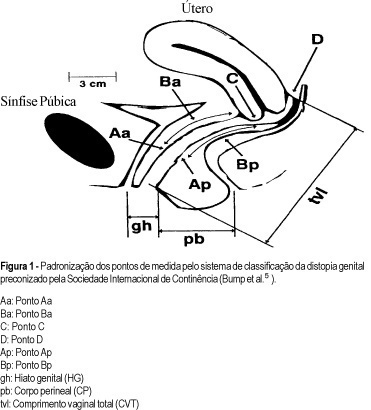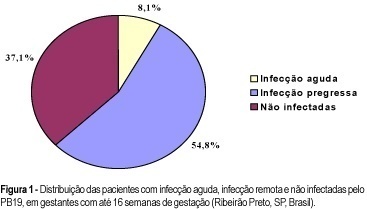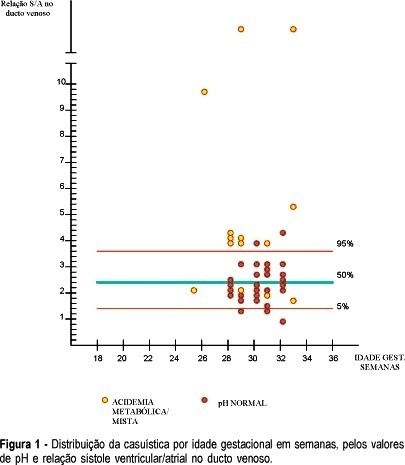Summary
Revista Brasileira de Ginecologia e Obstetrícia. 2003;25(5):353-358
DOI 10.1590/S0100-72032003000500008
PURPOSE: to determine interobserver reliability of site-specific measurements and stages according to the proposed International Continence Society prolapse terminology document. METHODS: we analyzed 51 women during urogynecological investigation performed at the Urogynecology and Vaginal Surgery Sector of UNIFESP / EPM. We recorded the locations of point-specific measures proposed by the International Continence Society (ICS). They are: two in the anterior vaginal wall, two in the superior vagina, two in the posterior vaginal wall, genital hiatus, perineal body and total vaginal length. Then we recorded the stage of genital prolapse. Women underwent pelvic examinations by two investigators, each blinded to the results of the other's examination. The reproducibility of the nine site-specific measurements and the summary stage were analyzed using Pearson's correlation coefficient and the median measurements were compared by the paired-t test. RESULTS: there were substantial and highly significant correlations for each of the nine measurements. Correlation coefficient for point Aa was 0.89 (p<0.0001), point Ba 0.90 (p<0.0001), point C 0.97 (p<0.0001), point Ap de 0.72 (p<0.0001), point Bp 0.84 (p<0.0001), point D 0.91 (p<0.0001), genital hiatus 0.65 (p<0.0001), perineal body 0.66 (p<0.0001) e total vaginal length 0.73 (p<0.0001). We also did not note differences between the means of measurements by the two examiners. Staging was highly reproducible (r=0.81, p<0.0001). ln no subject did the stage vary by more than one; in 86,2%, stages were identical. CONCLUSIONS: there is a good reproducibility of measures using the system proposed by the International Continence Society prolapse terminology document.

Summary
Revista Brasileira de Ginecologia e Obstetrícia. 2003;25(5):331-335
DOI 10.1590/S0100-72032003000500005
PURPOSE: to evaluate whether there is an association between recurrent spontaneous abortion and atopy. METHODS: this was a case-control study with 230 women: 71 with a history of recurrent spontaneous abortion (group A) and 159 with a history of successful pregnancy (group B). The evaluation included a questionnaire in order to investigate the personal history of atopy, considering symptoms of atopic dermatitis, urticaria, rhinitis, asthma, conjunctivitis and gastric or intestinal symptoms. The presence of specific IgE in response to a pool of inhalants, Phadiatop, detected by an enzymatic fluorescence reaction in blood was also investigated. The data were analyzed by Fisher's exact test and a p value < 0.05 was set as level of significance. RESULTS: a positive history of atopy was observed in 57.7% of group A patients and in 55.3% of group B patients. The incidence of positive IgE against Phadiatop was 38% and 33.9% in groups A and B, respectively. Association of allergy disease with positive Phadiatop (presence of specific IgE) was detected in 28.2% of group A and in 22% of group B patients. There was no significant difference between the groups. CONCLUSIONS: we did not observe any association between recurrent spontaneous abortion and atopy.
Summary
Revista Brasileira de Ginecologia e Obstetrícia. 2003;25(5):323-328
DOI 10.1590/S0100-72032003000500004
PURPOSE: to determine whether an elective cesarean section at the 38th week of gestation for HIV positive patients, in spite of decreasing vertical transmission, increases the risk of maternal death. METHODS: fifty-eight HIV-infected patients were studied and submitted to the complete ACTG 076 protocol (oral administration of zidovudine in the prenatal period associated with the intravenous form at delivery) followed by an elective cesarean section at the 38th week of gestation. The control group consisted of 226 noninfected women (the first four patients submitted to an elective cesarian section after each cesarian section in infected patient). The analyzed variables were: uterine atonia, puerperal fever, abdominal wall infection, urinary infection, endometritis, average blood loss, surgery time, and hospitalization time. Data were analyzed by the c² test (the Fisher test was used when there were less than 5 cases). The relative risk was calculated with the Epi-Info 6.0 program. RESULTS: results show that the elective cesarean section performed on HIV-positive patients, when compared to the control group, did not present a higher incidence of uterine atonia, puerperal fever, abdominal wall infection, urinary infection or endometritis. However, a greater average blood loss (2.26 relative risk) was recorded as well as an extended surgery time (3.32 relative risk). The HIV-infected patients remained less time in hospital than the noninfected control group (0.33 relative risk). CONCLUSION: we conclude that there was no increase in maternal morbidity after cesarean section as a means of interrupting gestation in the HIV-infected patients.
Summary
Revista Brasileira de Ginecologia e Obstetrícia. 2003;25(5):317-321
DOI 10.1590/S0100-72032003000500003
PURPOSE: to evaluate the rate of seropositivity for parvovirus B19 (PB19) among pregnant women and the rate of seroconversion against this infection during pregnancy. METHODS: prospective study carried out in the Hospital of the Medical School of Ribeirão Preto, University of São Paulo. In the first stage of the present study, we evaluated 245 pregnant women with gestational age less than 16 weeks to determine the seroprevalence of PB19 infection by ELISA. According to the serological results we determined if the PB19 infection was an acute infection (IgM positive and IgG negative or positive), or a former infection (IgM negative and IgG positive). In the second stage of this study, 73 previously seronegative pregnant women were tested again when they came to the hospital for delivery (IgM and IgG), to detect the seroconversion rate during pregnancy. RESULTS: the seroprevalence of the PB19 infection until 16 weeks of gestation was 62.9% (95% IC: 56.8-68.9), divided into acute infection (8.1%), or former infection (54.8%). Of the 73 patients, seronegative in the first stage of this investigation, seven (9.6%) showed seroconversion during pregnancy (95% IC: 2.8-16.3), two (2.7%) showed acute serological infection and five (6.9%) presented markers of past infection. The final seroprevalence of PB19 infection during pregnancy was 72.5%. CONCLUSIONS: considering that only the acute PB19 infection is associated with risk for vertical transmission, the high seroprevalence of this infection observed in this study would be protecting these fetuses against this form of infection. Despite the relatively high rate of seroconversion against PB19 infection during the pregnancy period, we did not observe any symptomatic neonate in this group.

Summary
Revista Brasileira de Ginecologia e Obstetrícia. 2003;25(5):309-316
DOI 10.1590/S0100-72032003000500002
PURPOSE: to determine the prevalence of domestic physical violence among women who delivered at a tertiary center in the Northeast of Brazil, to study the main risk factors associated with domestic violence, and to determine perinatal outcome. METHODS: a cross-sectional study was conducted, enrolling 420 women who delivered at a tertiary center in Recife (Brazil) with fetuses weighing more than 500 g. They were submitted to interviews with open and closed questions. The prevalence of domestic physical violence was determined. Statistical analysis was performed using c² and Fisher's exact tests at a 5% level of significance. The prevalence ratio was determined as measurement of relative risk of violence. Multiple logistic regression analysis was performed and the adjusted risk was calculated. RESULTS: the prevalence of domestic physical violence was 13.1% (95% CI = 10.1-16.6) and 7.4% (95% CI = 5.2-10.2) before and during pregnancy, respectively. The pattern of violence has changed during pregnancy: stopped in 43.6%, was reduced in 27.3% and increased in 11% of the victims. After multivariate analysis the variables that persisted strongly associated with violence were low female educational level, history of violence in the women´s family, partner's use of alcohol and unemployment. Perinatal outcome was studied and a significantly higher frequency of neonatal death was observed among victims of domestic violence. CONCLUSIONS: a high prevalence of domestic physical violence was observed (about 13%) in women who delivered at a tertiary center in Northeast of Brazil. The main risk factors were low educational level and previous familiar history of violence in the women's family, alcohol use by and unemployment of their partners. Neonatal mortality was increased in victims of violence.
Summary
Revista Brasileira de Ginecologia e Obstetrícia. 2003;25(4):277-281
DOI 10.1590/S0100-72032003000400009
PURPOSE: the aim of the present study was to evaluate the accuracy of microalbuminuria to predict preeclampsia. METHODS: a prospective study of 45 consecutive diabetic gestations that were tested for microalbuminuria before the 18th week, between the 18th and 24th week and between the 32nd and 36th week of gestation. All patients had their prenatal care done from January 2000 to December 2001. The DCA 2000 microalbumin/creatinine assay is a quantitative method for measuring low concentrations of albumin, creatinine and the albumin/creatinine ratio in urine. According to laboratory standards, an albumin/creatinine ratio >16 mg/g (1.8 mg/mmol) indicates incipient renal damage and risk for preeclampsia. The sensitivity, specificity, positive and negative predictive values of the albumin/creatinine ratio were determined to predict the occurrence or the absence of preeclampsia, diagnosed through clinical criteria. RESULTS: of all patients, 17% developed preeclampsia. The sensitivity of albumin/creatinine ratio increased from 12.5% at 18 weeks to 25% between the 18th and 24th week and to 87% after the 32nd week. On the other hand, specificity presented a decreasing value from 97 to 89 and 83%, respectively). The positive predictive value was relatively low in the three different periods of evaluation (50, 33 and 53%, respectively. The negative predictive value was increased in the three stages of gestational age (83, 84 and 96%, respectively). CONCLUSIONS: quantification of microalbuminuria could correctly predict the absence of preeclampsia but was less accurate to predict the occurrence of the disease in diabetic pregnancies.
Summary
Revista Brasileira de Ginecologia e Obstetrícia. 2003;25(4):271-276
DOI 10.1590/S0100-72032003000400008
PURPOSE: to perform a comparative study between uterine curettage and manual vacuum aspiration (MVA) in the treatment of first-trimester miscarriages. METHODS: a hundred and two patients were included up to the 12th week of pregnancy, with diagnosis of miscarriage, admitted at Maternidade Escola Januário Cicco, between January 1998 and July 2001, and who were randomly submitted to uterine curettage or to MVA. The analyzed variables were: pain control, need of mechanical cervical dilation, uterine emptying time, incidence of complications and stay in hospital. The patients were reevaluated clinically and echographycally between 7 and 10 days after the procedures. The chi2 test was used for statistical analysis. RESULTS: general anesthesia was used in all the patients submitted to uterine curettage and in none of those who were submitted to MVA, whose pain was controlled with local anesthesia in 64% of the cases. The differences between the two methods concerning the need of mechanical cervical dilation, emptying time and incidence of complications were not significant. The stay in hospital was significantly shorter in patients submitted to MVA. CONCLUSIONS: no advantage of one method over the other was observed in regard to the technique and the incidence of complications. The unneeded use of general anesthesia and the significantly shorter stay in hospital indicate that MVA should be recommended for all services with obstetrical assistance, increasing resolvability of the cases and decreasing risks, improving the quality of assistance.

Summary
Revista Brasileira de Ginecologia e Obstetrícia. 2003;25(4):261-268
DOI 10.1590/S0100-72032003000400007
PURPOSE: to evaluate Doppler velocimetry of the ductus venosus as a noninvasive test of abnormal pH and gas analysis in preterm fetuses with "brain sparing reflex". METHODS: a cross-sectional study was performed. The studied population consisted of 48 pregnant women between the 25th and the 33rd week of gestation, whose fetuses presented brain sparing reflex (umbilical/cerebral ratio >1). The time elapsed between Doppler velocimetry and the birth (cesarean section under peridural anesthesia) was of up to 5 h. The following parameters were studied: S/A ratio of the ductus venosus, pH and base excess (BE) of fetal blood sample (collected from the umbilical vein immediately after birth). The S/A ratio of the ductus venosus was considered abnormal when superior to 3.6. The fetuses were classified according to the gas analysis result. They were considered abnormal when pH <7.26 and BE £ 6 mMol/L. Fisher's test was used for statistical analysis and considered significant when p £ 0.05. RESULTS: there was a significant correlation between umbilical blood gas analysis in preterm fetuses with brain sparing reflex and ductus venosus S/A ratio (p = 0.0000082; Fisher test). Ductus venosus Doppler velocimetry identified 10 of 14 fetuses with abnormal gas analysis. On the other hand, 32 of 34 fetuses with normal gas analysis were correctly identified. The sensitivity of the ductus venosus S/A ratio for the diagnosis of abnormal blood gas analysis was 71%, specificity 94%, false-negative rate 8%, false-positive rate 4%, positive predictive value 83% and negative predictive value 89%. Pretest likelihood, post-test posterior probability following a positive test result (post-test likelihood) and post-test posterior probability following a negative test result (post-test likelihood) were 31, 84 and 10%, respectively. CONCLUSION: the analysis of the ductus venosus S/A ratio is adequate for the diagnosis of abnormal blood gas analysis in preterm fetuses presenting brain sparing reflex.
